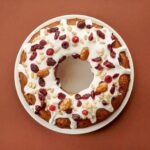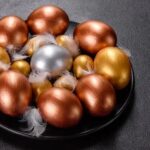A beautifully decorated cake can be the centerpiece of any celebration, from birthdays to weddings. But ensuring that the decoration stays intact and looks flawless requires proper covering techniques. In this article, we will explore how to cover a decorated cake effectively, whether you’re using buttercream, fondant, or ganache.
Covering a cake is not just about aesthetics; it also plays a critical role in preserving the moisture and freshness of the cake itself. A well-covered cake helps seal in flavors and prevent them from drying out. Additionally, the covering serves as a smooth canvas for intricate decorations and designs to be applied on top.
Different types of frostings offer varying advantages and challenges when it comes to covering a cake. From the rich and creamy buttercream to the versatile fondant and decadent ganache, each has its unique characteristics that can enhance the overall look and taste of your creation. Understanding how to work with these different frostings is essential for achieving professional-looking results.
Types of Frosting to Use
When it comes to covering a decorated cake, choosing the right type of frosting is crucial. The three most popular options are buttercream, fondant, and ganache, each with its own advantages and disadvantages. Here is a breakdown of each type to help you decide how to cover your cake:
- Buttercream: Buttercream is a versatile frosting that is easy to make and work with. It can be flavored in various ways and is great for piping decorations. However, buttercream can be prone to melting in warm temperatures and may not provide as smooth a finish as fondant.
- Fondant: Fondant is a sugar paste that can be rolled out and draped over the cake for a flawless finish. It gives cakes a sleek look and allows for intricate designs. On the downside, fondant can be tricky to work with for beginners and has a distinct taste that not everyone enjoys.
- Ganache: Ganache is made from chocolate and cream, creating a rich and decadent frosting option. It sets firm, making it great for sculpted cakes or drip designs. However, ganache can be heavy and may not hold up well in warm conditions.
Each type of frosting offers unique possibilities for decorating your cake, so consider the design you want to achieve and the conditions in which the cake will be served before making your choice on how to cover decorated cake.
Preparing Your Cake for Covering
Decorating a cake is not just about making it look visually appealing, but also ensuring that the final product tastes delicious. One crucial step in achieving a beautifully decorated cake is properly preparing it for covering. This includes crumb coating, leveling, and chilling the cake before applying any frosting or fondant.
Crumb coating is the initial layer of frosting that traps any loose crumbs, providing a smooth surface for the final coat. It helps in achieving a clean and polished look once the cake is fully covered.
Leveling the cake is another essential step to ensure that the layers are even and uniform. Uneven layers can lead to an unstable and lopsided cake once covered, affecting both its appearance and structural integrity. Using a serrated knife or cake leveler, carefully trim off any domed tops to create flat surfaces that are ready for stacking and covering.
Chilling the cake after crumb coating and leveling is crucial as it helps set the frosting or fondant before adding additional layers or decorations. This process allows for better adherence of subsequent coatings and prevents any smudging or sliding of decorations. By following these preparatory steps diligently, you can lay a solid foundation for creating a beautifully decorated cake that will impress your guests.
| Preparation Step | Description |
|---|---|
| Crumb Coating | Initial layer of frosting to trap crumbs for smooth surface |
| Leveling | Trimming uneven layers to create flat surfaces for stacking |
| Chilling | Setting the initial coating before adding more layers or decorations |
How to Cover a Cake With Buttercream
Covering a cake with buttercream is a classic and versatile way to decorate a cake. Buttercream is smooth, creamy, and easily customizable in terms of color and flavor. Learning how to cover a cake with buttercream properly can elevate your baking skills and create beautifully finished cakes for any occasion.
Gather Your Supplies
Before you start covering your cake with buttercream, make sure you have all the necessary supplies ready. You will need a crumb-coated and chilled cake, a turntable for easier frosting application, an offset spatula for smooth spreading, and a bench scraper for even coverage. Additionally, prepare your preferred buttercream recipe ahead of time and ensure it’s at the right consistency for spreading.
Applying the Crumb Coat
Start by applying a thin layer of buttercream to the chilled cake to seal in any loose crumbs. This step is crucial to achieving a smooth final coat of buttercream. Use your offset spatula to spread the buttercream evenly over the entire surface of the cake. Once the crumb coat is applied, chill the cake again to set the buttercream before moving on to the final coat.
Applying the Final Coat
To apply the final coat of buttercream, start by adding a generous amount of buttercream to the top of your chilled cake. Use your offset spatula to spread it evenly over the top and sides of the cake while rotating it on the turntable for even coverage. Once the entire cake is covered, use a bench scraper held vertically against the sides of the cake to smooth out any excess buttercream and create sharp edges on your finished product.
Mastering how to cover decorated cakes with buttercream takes practice and attention to detail. By following these steps and tips for smooth and even coverage, you can create professional-looking cakes that are both delicious and visually appealing.
How to Cover a Cake With Fondant
Fondant is a popular choice for covering cakes due to its smooth and flawless finish, making it perfect for special occasions like weddings or birthdays. Learning how to cover a cake with fondant requires practice and patience, but the results are worth it. Here is a step-by-step guide on how to cover a cake with fondant, along with tips and techniques for achieving a flawless finish:
- Rolling Out the Fondant: Start by kneading the fondant until it is smooth and pliable. Dust your work surface with powdered sugar to prevent sticking, then use a rolling pin to roll out the fondant into a thin, even layer that is large enough to cover the entire cake.
- Lifting the Fondant: Carefully lift the rolled-out fondant using a rolling pin or your hands and drape it over the chilled, frosted cake. Gently smooth out any air bubbles or wrinkles using your hands or a fondant smoother, starting from the center and working towards the edges to avoid tearing.
- Smoothing Out Techniques: To achieve a flawless finish, use a fondant smoother or flexible plastic scraper to gently press the fondant against the sides of the cake while smoothing out any creases or excess fondant at the base. Trim off any excess fondant using a sharp knife or pizza cutter for clean edges.
With practice and attention to detail, you can master the art of covering cakes with fondant and create stunning designs that will wow your friends and family. Remember to be patient and take your time when working with fondant, as it can be finicky but rewarding once you get the hang of it.
Overall, mastering how to cover a decorated cake with fondant opens up endless possibilities for creativity and customization. Whether you’re aiming for a sleek modern design or intricate details for a themed cake, fondant provides a versatile canvas for your artistic vision. Experiment with different colors, textures, and shapes to create show-stopping cakes that will be remembered long after they’ve been enjoyed.
Troubleshooting Common Issues
When working on decorating a cake, it is not uncommon to encounter common issues such as cracks, tears, and air bubbles that can affect the overall appearance of your creation. Knowing how to fix these problems can help you achieve a flawless and professional-looking finished product.
One common issue that may arise when covering a decorated cake is the presence of cracks in the frosting or fondant. Cracks can occur due to various reasons, such as improper handling of the cake or using too thin of a layer of frosting.
To fix cracks in buttercream frosting, you can gently warm an offset spatula with hot water and smooth over the crack to blend it in seamlessly. For fondant-covered cakes, apply a small amount of shortening to your fingers and rub it over the crack to soften and smooth out the area.
Another issue that decorators may face is tears in the fondant when covering a cake. Tears can happen if the fondant is stretched too much during application or if it is too dry. To repair tears in fondant, gently lift the torn area and apply a small amount of water underneath before pressing it back into place. Use a fondant smoother to blend the edges together for an invisible repair.
Air bubbles are also a common problem that can occur when covering a cake with frosting or fondant. These unsightly bubbles can ruin the smooth finish of your decorated cake.
To fix air bubbles in buttercream, use a small pin to prick the bubble gently and then smooth out the area with an offset spatula. When dealing with air bubbles in fondant, carefully puncture the bubble with a clean needle and press down on the area to release any trapped air, then smooth out the surface for a seamless look.
| Cake Issue | Repair Method |
|---|---|
| Cracks | Warm spatula for buttercream; apply shortening for fondant |
| Tears | Lift torn area, apply water underneath, use smoother for blending |
| Air Bubbles | Prick bubble with pin; press down & smooth (buttercream); puncture bubble and smooth (fondant) |
Creative Decorating Ideas
Decorating a cake goes beyond just covering it with frosting or fondant; it’s a chance to showcase your creativity and make the dessert truly stand out. Using piping techniques, edible decorations, and other creative ideas can take your decorated cake to the next level. Whether you’re designing a cake for a special occasion or just want to impress your friends and family, there are plenty of ways to enhance the visual appeal of your creation.
Piping Techniques
Piping is a versatile decorating technique that allows you to add intricate designs, borders, and textures to your cake. With different piping tips and techniques, you can create elegant swirls, flowers, leaves, stars, and more. Practice with different piping bags and nozzles to achieve unique patterns and designs on your cake. Adding piped details can elevate the overall look of your decorated cake and make it more visually appealing.
Using Edible Decorations
Edible decorations provide a fun and delicious way to enhance the appearance of your decorated cake. From edible flowers and sugar pearls to fondant figures and chocolate curls, there are endless possibilities for adding extra flair to your dessert.
Consider incorporating edible glitter, sprinkles, candy letters or numbers, or even printed wafer paper images for a personalized touch. The key is to choose decorations that complement the theme or color scheme of the cake while adding an extra layer of visual interest.
Creative Design Ideas
Get inspired by various sources such as nature, art, fashion trends, or even current events when coming up with creative design ideas for your decorated cake. Experiment with sculpting tools, stencils, food coloring techniques like painting or airbrushing for unique effects.
Think outside the box when it comes to themed cakes – consider creating sculpted cakes shaped like objects or animals using layers of fondant. Remember that creativity knows no bounds when it comes to decorating cakes; let your imagination run wild.
Storage and Serving Tips
Properly storing a decorated cake is crucial to preserving its freshness and design. Whether you have chosen to cover your cake with buttercream or fondant, ensuring that it remains in the best condition possible is essential. After all the hard work put into decorating, it would be a shame if the cake’s appearance and taste were compromised due to improper storage.
To store a decorated cake covered with buttercream, it is ideal to keep it refrigerated in an airtight container. Make sure the container is large enough to accommodate the size of the cake without touching the frosting. This will prevent any smudging or damage to the design. Remember to bring the cake back to room temperature before serving to bring out its full flavor.
For cakes covered in fondant, keeping them in a cool, dark place is key. Avoid direct sunlight or high temperatures as they can cause the fondant to melt or sweat. If needed, refrigerate the fondant-covered cake but allow it to come back to room temperature slowly before serving.
Always cover the stored cake with a clean kitchen towel or plastic wrap to protect it from dust and moisture. By following these storage tips, your decorated cake will stay fresh and visually appealing for longer periods of time.
When it comes time to serve your beautifully decorated cake, remember that presentation matters just as much as taste. Use a sharp knife dipped in hot water for clean slices and showcase the design by cutting with precision. Serve each piece on individual plates with care so that every slice looks just as delightful as the whole cake itself. With these storage and serving tips in mind, you can confidently create, store, and present your decorated cakes like a pro.
Frequently Asked Questions
How Do You Cover a Cake Without Ruining the Icing?
To cover a cake without ruining the icing, I recommend using a cake dome or large overturned bowl to protect the icing from being smudged or ruined. Make sure the dome does not touch the icing.
How Do You Cover a Decorated Cake Overnight?
When covering a decorated cake overnight, it is best to use toothpicks and plastic wrap. Gently insert toothpicks around the top of the cake, then cover with plastic wrap ensuring that it doesn’t touch any decorations.
How Do You Cover a Frosted Cake in the Fridge?
If you need to store a frosted cake in the fridge, first allow the frosting to set by leaving it uncovered in the fridge for about an hour. Then, loosely cover the entire cake with plastic wrap to prevent drying out. Make sure there is enough space so that the wrap doesn’t stick to the frosting.

Welcome to my blog about home and family. This blog is a place where I will share my thoughts, ideas, and experiences related to these important topics. I am a stay-at-home mom with two young children. I hope you enjoy reading it! and may find some helpful tips and ideas that will make your home and family life even better!





